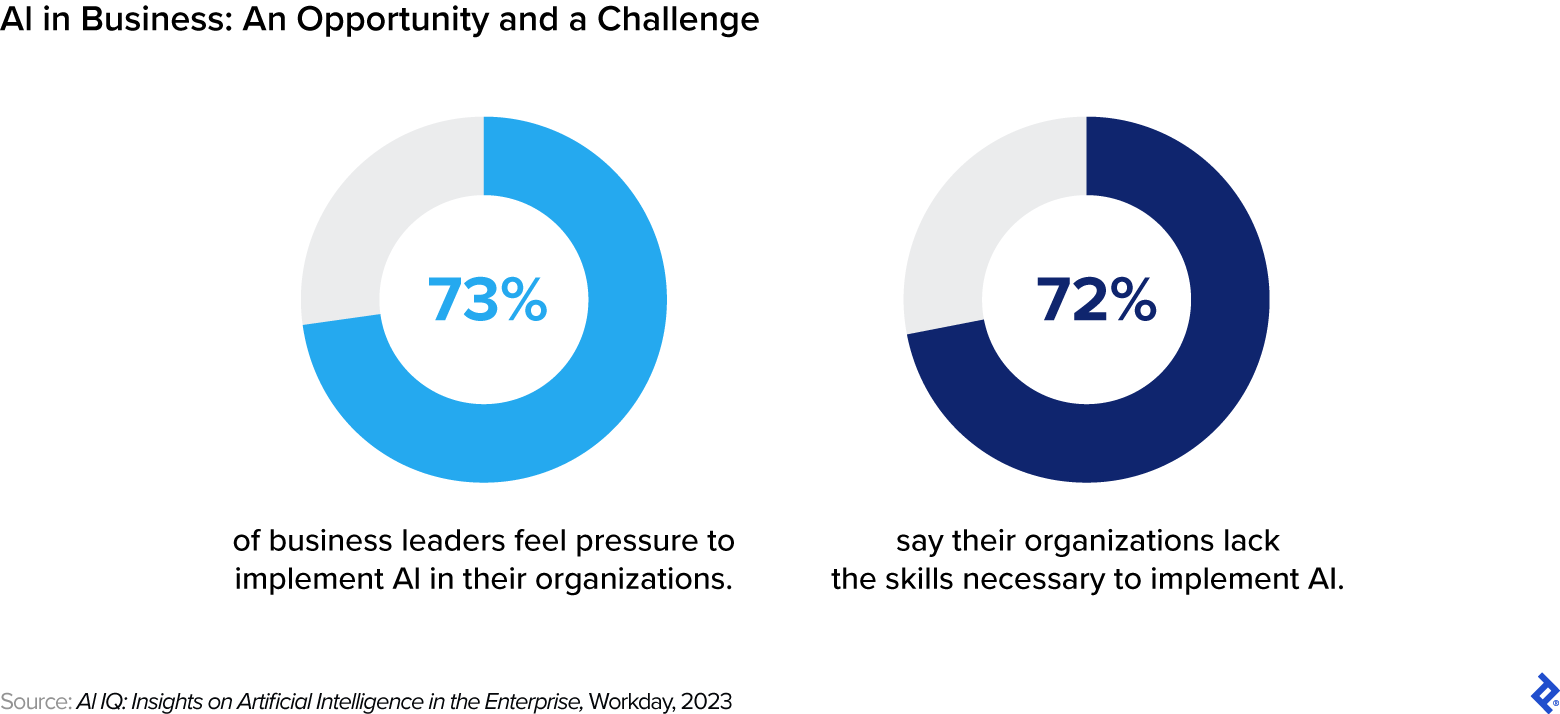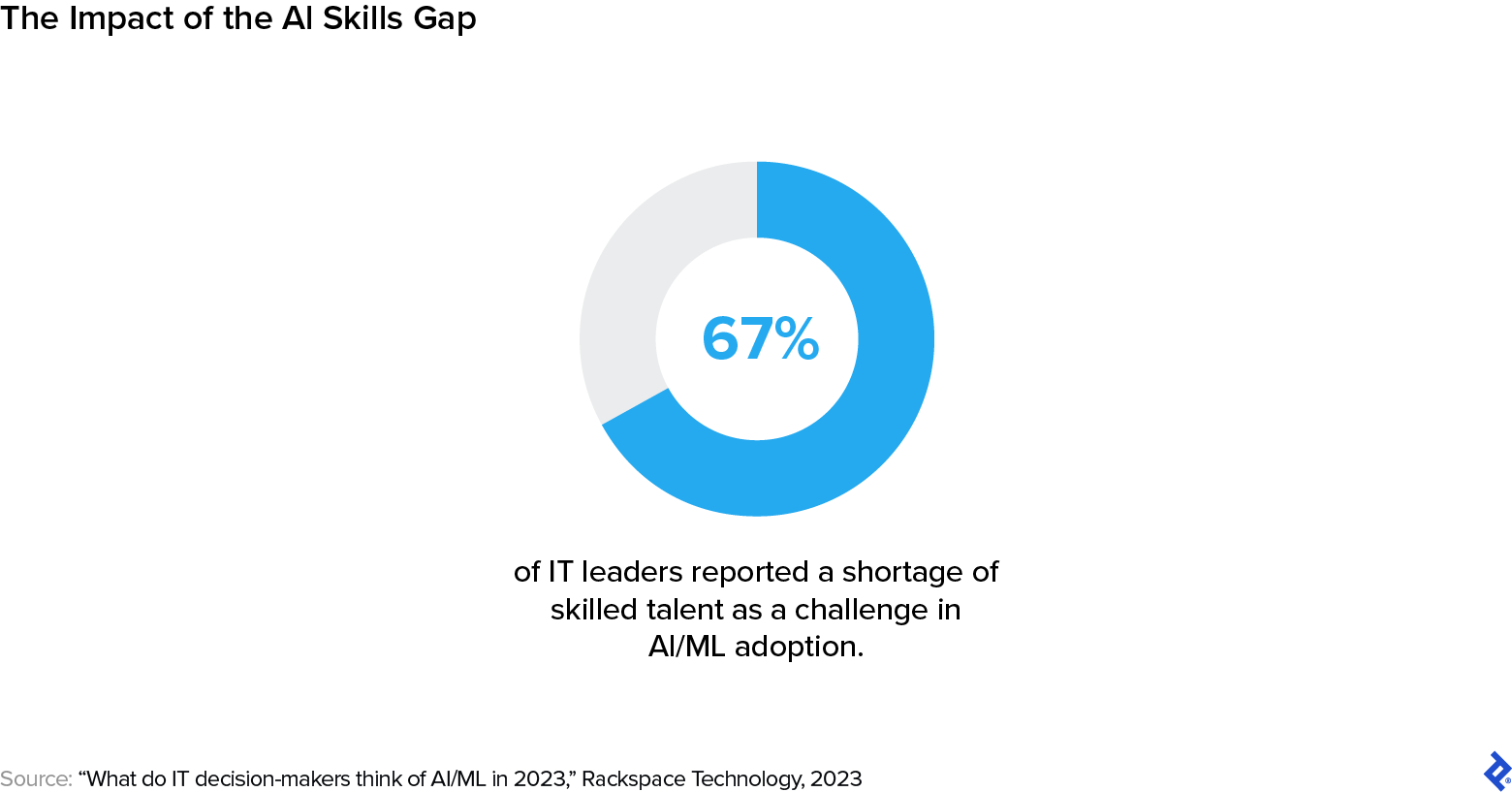Evolving Your Product Strategy: 3 Principles for Successful AI Integration
For product businesses, embracing the transformative power of AI means incorporating it in a robust, relevant, and sustainable way. Navigate the challenges of AI integration with this guide.
For product businesses, embracing the transformative power of AI means incorporating it in a robust, relevant, and sustainable way. Navigate the challenges of AI integration with this guide.
Nishant is a product leader and business development consultant with more than a decade of experience. He uses his knowledge of AI and ML to inform business strategies, most recently in building intelligent supply chains for a global food and beverage company. By spearheading innovative approaches at organizations including Royal Caribbean Group and Carnival Cruise Lines, he has helped teams evolve, embrace challenges, and deliver lasting value.
Previous Role
Senior Product ManagerPREVIOUSLY AT


Technology tends to move more quickly than business, and the advancement of artificial intelligence (AI) is setting new records. As AI continues to evolve at a staggering rate, businesses are being confronted with both unprecedented opportunities and formidable challenges: A recent survey by Workday found that 73% of business leaders feel pressure to implement AI in their organizations, but 72% say their organizations lack the skills needed to do so. This predicament intensifies when we consider the implications of AI on product strategy: AI accelerates the speed of delivering products while simultaneously amplifying uncertainty around which solutions will triumph.
The challenge for businesses isn’t just adopting AI technology, it’s weaving AI into the fabric of their products in a way that enhances user experience, drives innovation, and creates a competitive advantage. This involves not only understanding the various forms and applications of AI, but also recognizing their potential to revolutionize development, customization, and engagement.
So how can businesses navigate the challenges of this rapid technological evolution and capitalize on the opportunities and potential market value presented by it? My experience leading numerous AI initiatives as a product leader and product development consultant has taught me that keeping pace with AI is not just a matter of implementation, it’s about identifying how the technology can benefit users and add value, deploying it strategically, and embracing a culture of continuous improvement. Here I explore what many leaders are doing wrong, and I share three core principles to align AI integration with product strategy.
AI Definitions and Applications
For business leaders, the key is not to think about AI as a piece of technology, but instead view it as a strategic asset that, when used responsibly and effectively, can lead to significant advancements in operations, customer experience, and decision-making. To leverage AI successfully, leaders first need to understand its forms and applications. Here are some definitions:
- Artificial intelligence (AI): At its core, AI aims to mimic human intelligence. This includes tasks such as learning, reasoning, problem-solving, and understanding language.
-
Artificial general intelligence (AGI) vs. narrow AI:
- AGI: Still only hypothetical, AGI would be capable of performing any intellectual task that a human can do, covering a broad range of expertise across multiple domains. Companies like Google and OpenAI are investing heavily in exploring AGI.
- Narrow AI: Narrow AI excels in performing a specific task, such as spam detection, facial recognition, or data analysis. It’s important to note that an AI proficient in one task may not necessarily excel in another.
- Machine learning (ML): A significant subset of AI, ML enables machines to learn from data without being explicitly programmed. It focuses on using algorithms to parse data, identify patterns, and make decisions. In essence, it’s about teaching machines to learn from experience. Netflix, for example, uses a browsing system that analyzes data such as a customer’s viewing history and the preferences of similar viewers in order to create personalized recommendations.
- Deep learning (DL): Deep learning uses neural networks inspired by the human brain to simulate human thinking. This subset of ML enables machines to process large data sets and is pivotal in applications such as image recognition and voice assistants. For example, Google Photos employs deep learning to categorize images, allowing users to search for specific objects, scenes, or faces. Training neural networks on millions of pictures enables the differentiation of objects like cars and bicycles and identification of landmarks such as the Statue of Liberty.
- Large language models (LLMs): LLMs are foundation models that process extensive text data. They are commonly utilized in customer service, content creation, and even software development. ChatGPT is the most prominent example of an LLM today.
Current use cases for AI in business include automating repetitive work, creating content, and generating insights from vast data sets. Marketing, sales, product, business development, operations, hiring—virtually every department can be improved or positively disrupted by utilizing AI tools for these tasks.
For product teams specifically, AI can provide insights drawn from user data, enabling them to tailor experiences and anticipate customer needs with unprecedented precision. From Netflix’s recommendations to Google Photos’ intuitive image categorization, AI is redefining the parameters of functionality and interaction.
Beyond its impact on consumer-facing products, AI is also revolutionizing B2B and internal products. Companies are leveraging AI to create intelligent supply chain systems that can predict disruptions, optimize inventory, and streamline logistics. AI algorithms can identify patterns and anomalies that would be impossible for humans to detect, enabling businesses to make proactive, data-driven decisions. This not only enhances operational efficiency but also contributes to a more resilient and responsive supply chain.
At every stage of the product life cycle—from ideation and development to launch and continuous improvement—AI stands as a promising catalyst for innovation. Its integration, however, must be guided by a clear vision, strategic alignment with business goals, and a relentless focus on delivering value to the end user.
What Are Leaders Currently Doing Wrong?
The allure of AI is undeniable, but rushing to its adoption without a clear strategy can be detrimental. Leaders, dazzled by the possibilities AI presents, often overlook the fundamental problems they initially sought to address. It’s crucial to remember that AI isn’t a panacea—it requires thoughtful and strategic integration. Misconceptions about the value of AI may derail its implementation in your business. Here are the areas that leaders most commonly get wrong when it comes to AI integration:
Focusing on Cost Reduction
Financial constraints are a genuine concern, especially for small businesses, but using AI solely for cost-savings can be a mistake. A 2023 McKinsey & Company report showed that only 19% of AI high performers (i.e., organizations that attributed at least 20% of earnings before interest and taxes to AI use) ranked reducing costs as their top objective. All other respondents cited their top objectives as increasing revenue from core business, increasing the value of offerings by integrating AI-based features or insights, or creating new businesses/sources of revenue.
When evaluating AI-based technologies, focus on the value added rather than cost reduction. And don’t expect immediate financial returns—AI is a long-term investment. Approach AI with patience and a clear understanding of its potential future benefits, not just its short-term gains.
Taking on Too Much
A common misstep is attempting to overhaul entire processes with AI from the outset. This approach often leads to unrealistic expectations. While it might seem tempting to build an AI system from the ground up, this approach can be resource-intensive and time-consuming, requiring specialized skills and knowledge. In a 2023 survey by Rackspace Technology, a shortage of skilled talent was found to be the main barrier to AI/ML adoption, with 67% of IT leaders citing it as a challenge. This talent gap can lead to inefficiencies or potential failures in AI initiatives.
To combat this talent gap, take a phased approach to AI adoption and talent acquisition. Starting small, with a focus on a single product or process, allows teams to gradually develop the necessary skills to use and understand AI. This provides the opportunity for gradual hiring, bringing in experts to support AI product goals as the organization’s capabilities grow. Not only does this make the process more manageable, but it also allows for continuous learning and adaptation, which are crucial for strategic AI integration.
Not Managing the Risks
With any AI application, ethical considerations must be at the forefront. The consequences of biased AI can be dire. A criminal justice algorithm used in Broward County, Florida, for example, disproportionately ranked defendants as “high risk” based on their race. Additionally, research has demonstrated that training natural language processing models on news articles can inadvertently lead them to exhibit gender bias. Vigilance in AI development and deployment is vital to avoid perpetuating existing biases.
Bias and Fairness
AI’s potential to perpetuate biases is significant: These systems learn from existing data, and any bias present in that data can be reflected in the AI’s decisions. Ensuring that the data used is fair and representative is crucial. Ways to mitigate these risks include:
- Comprehensive data collection: Ensure that the data used to train AI systems is diverse and representative. This can be done by collecting data from a variety of sources and amplifying underrepresented groups. It is also important to exclude sensitive attributes from the data, such as race, gender, and religion, unless they are absolutely necessary for the model to perform its task.
- Enhanced model development: There are a number of techniques that can be used to train unbiased AI models. Adversarial models, for example, work by generating training data that is designed to trick the model into making mistakes, which then helps to identify and mitigate biases in the model.
- Judicious model deployment: Once a model has been trained, deploy it in a way that minimizes bias. This can be done by adjusting decision thresholds and calibrating outputs for fairness.
- Conscious diversity hiring: It is important to have diverse teams working on AI systems, so that potential biases can be spotted and mitigated. It is equally important to engage with groups affected by bias to understand the challenges they face and to ensure that their needs are met.
- Continuous monitoring: Audit the systems regularly and periodically conduct third-party reviews.
Transparency and Accountability
As AI systems become more integrated into decision-making processes, understanding how these decisions are made becomes imperative. Establishing processes for governance and accountability is essential to maintain trust and responsibility. This can include the following steps:
- Publishing the data and algorithms used by the system in a public repository or making them available to a select group of experts for review. This allows people to inspect the system and identify any potential biases or problems.
- Providing clear documentation of the system’s purpose, training data, and performance. This helps people understand how the system works and what to expect from it.
- Developing tools and techniques to explain the system’s predictions. This allows people to understand why the system made a particular decision and to challenge the decision if necessary.
- Establishing clear mechanisms for human oversight of the system. This could involve having a human review the system’s decisions before they are implemented or having a human-in-the-loop system in which the human can intervene in the decision-making process.
3 Principles for AI Integration
Businesses and product leaders can harness the transformative power of AI by understanding and addressing the problem/solution space. Adhere to these three foundational principles for successful AI integration:
Stay Customer-centric
It’s easy to get swept up in the AI wave, but the heart of your business should always remain the customer, and you should be guided by your mission, vision, and values. Ensure you don’t skip these vital steps:
- User discovery and market insight: Before diving into solutions, understand and prioritize opportunities through user feedback, market research, competitive analysis, market sizing, and alignment with your overall company strategy and objectives.
- Solution brainstorming: Once you’ve prioritized, zoom in on the most impactful areas and tailor solutions to meet specific needs and desires of your users.
Be Strategic About AI Deployment
AI offers a plethora of opportunities, but it should be used with purpose and precision. Hasty or indiscriminate AI deployment can squander resources and dilute focus, so follow this workflow to maximize success:
- Identify opportunities: Pinpoint specific product and operational challenges that can be addressed using AI.
- Deploy strategically: Treat AI as a specialized tool in your toolkit. Employ it where it can make the most difference, and always with a clear purpose. Don’t use AI for AI’s sake.
- Align solutions: Ensure AI solutions elevate your value proposition and contribute to overarching objectives.
Maintain a Product Management Approach
AI and related technologies have revolutionized the speed and efficiency of transforming ideas into reality. Though opportunities can be identified and hypotheses or solutions can be tested and refined faster than ever, it’s still important to abide by the fundamentals of product management:
- Maintain a balance: AI can accelerate the journey from idea to execution, but don’t bypass key phases. While agility is crucial, never skip product and customer discovery.
- Iterate and refine: Start with a minimal viable product, gather feedback, hone it, and then scale. Adopt a fixed-time, variable-scope approach, beginning with pilot programs. Draw from the insights, refine, and progressively roll out.
- Stay informed: AI is a dynamic field. Emphasize ongoing learning and flexibility to fully harness its ever-evolving potential. Embrace a culture of continuous improvement.
By adopting these three principles, businesses can position themselves at the forefront of the AI revolution in a robust and relevant way.
Don’t Adapt, Thrive
Embracing AI involves much more than just technology integration. The key to success lies in developing a clear, strategic approach and ensuring your product strategy is flexible, data-driven, and attuned to the evolving expectations of users. The transformative potential of AI is vast, but its power can only be harnessed effectively when businesses stay rooted in customer-centric values, make judicious choices, and foster a culture of continuous learning. This is the formula for not just adapting to, but thriving in, the era of AI, ensuring the long-term success and relevance of your business. For those ready to embark on this journey, begin with an AI audit, evaluating your current product strategy and pinpointing potential areas for integration. The road ahead will be filled with challenges, but also unparalleled opportunities for growth, innovation, and differentiation.
Further Reading on the Toptal Blog:
Understanding the basics
How do you integrate AI with product strategy?
When integrating AI with your product strategy, adhere to these three principles: Stay customer-centric, be strategic about deployment, and maintain a product management approach. This will ensure that your business can harness the transformative power of AI in a robust and sustainable way.
How do you implement AI successfully?
In order to implement AI in your business successfully, don’t make cost reduction your primary focus, don’t take on too much at once, and ensure you manage the ethical risks by eliminating bias and maintaining transparency and accountability.
Miami, FL, United States
Member since June 1, 2022
About the author
Nishant is a product leader and business development consultant with more than a decade of experience. He uses his knowledge of AI and ML to inform business strategies, most recently in building intelligent supply chains for a global food and beverage company. By spearheading innovative approaches at organizations including Royal Caribbean Group and Carnival Cruise Lines, he has helped teams evolve, embrace challenges, and deliver lasting value.
Previous Role
Senior Product ManagerPREVIOUSLY AT





